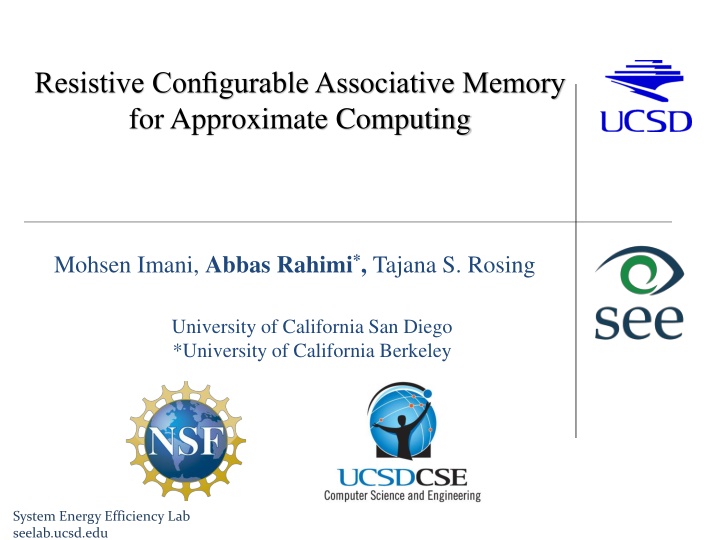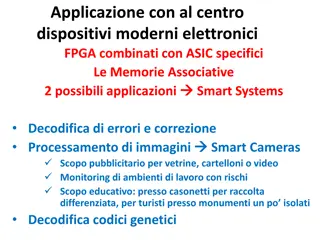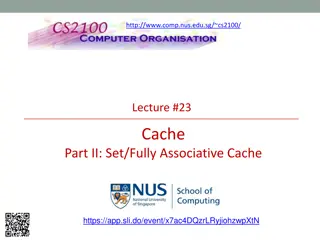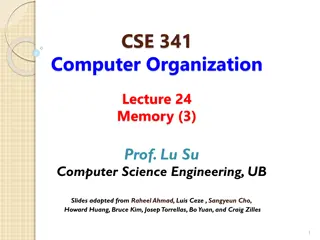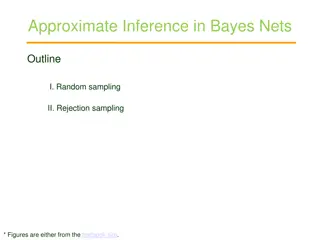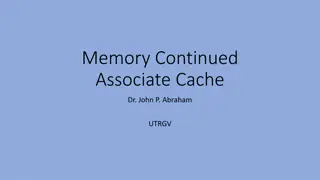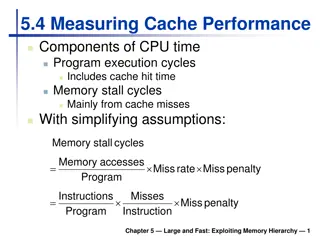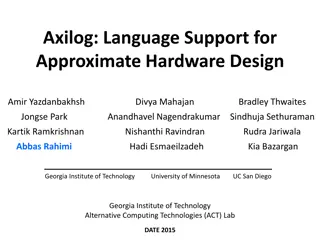Resistive Configurable Associative Memory for Approximate Computing
Resistive Configurable Associative Memory is explored as a solution for the energy efficiency requirements in the Internet of Things era. This technology aims to address the challenges posed by the massive scale of interconnected devices, data generation needs, and battery-powered operations. Leveraging associative memories for computation offers a promising approach to achieve low energy consumption, high speed, and efficient system performance.
Uploaded on Feb 26, 2025 | 1 Views
Download Presentation

Please find below an Image/Link to download the presentation.
The content on the website is provided AS IS for your information and personal use only. It may not be sold, licensed, or shared on other websites without obtaining consent from the author.If you encounter any issues during the download, it is possible that the publisher has removed the file from their server.
You are allowed to download the files provided on this website for personal or commercial use, subject to the condition that they are used lawfully. All files are the property of their respective owners.
The content on the website is provided AS IS for your information and personal use only. It may not be sold, licensed, or shared on other websites without obtaining consent from the author.
E N D
Presentation Transcript
Resistive Configurable Associative Memory for Approximate Computing Mohsen Imani, Abbas Rahimi*, Tajana S. Rosing University of California San Diego *University of California Berkeley System Energy Efficiency Lab seelab.ucsd.edu
Motivation Internet of Things (IoT): Billions~Trillions of interconnected devices (large scale problem) Amount of data generation in 2011 1.8 zettabytes which will be increased by 50% in 2020! Battery powered tight energy efficiency requirements Software Operating System Architecture Components Technology Materials System Energy Efficiency Lab seelab.ucsd.edu 2
Motivation Internet of Things (IoT): Billions~Trillions of interconnected devices (large scale problem) Amount of data generation in 2011 1.8 zettabytes which will be increased by 50% in 2020! Battery powered tight energy efficiency requirements A promising solution: use of associative memories Not a new technique, but a new application field! Result of computation Input operands Processor Pipeline Clock gating Look up Table MEM Matching? Requirements: low area, low energy, fast System Energy Efficiency Lab seelab.ucsd.edu 3
Related Work Energy efficient computation Associative memory ( Computation with memory ) [Kohonen 2012] Energy efficient computing units Lower energy consumption CMOS-based [Lakshminarayanan 2005] NVM-based [Li 2012] Higher search speed and area efficiency MTJ [Matsunaga 2012] Memrist [Li 2012] Approximate matching (VOS) [Rahimi 2015] Exact matching [Rahimi 2014] Lower energy consumption (at the cost of accuracy) VOS: Voltage OverScaling Energy efficient resistive associative memories ! System Energy Efficiency Lab seelab.ucsd.edu 4
Resistive Associative Memory (1/2) Result of computation Input operands Processor Pipeline Clock gating Look up Table MEM Row Cell TCAM: Ternary Content Addressable Memory - Energy proportional to hit rate The higher the TCAM size, the higher hit rate GOAL: Lower TCAM energy to achieve higher energy efficiency saving is - - Number of rows Word size System Energy Efficiency Lab seelab.ucsd.edu 5
Resistive Associative Memory (2/2) Limitations of conventional Resistive TCAM: Word size Number of rows Search energy - Long word High leakage current - Lots of rows Large and energy hungry input buffers - Search operation All TCAM rows require precharging Vdd Energy Solutions? Input Buffer Higher Hit Rate Low Energy TCAM Online Profiling Approximation System Energy Efficiency Lab seelab.ucsd.edu 6
Profiling (1/3) Hit rate Larger TCAM Online profiling Energy limitation Cost of profiling? How much energy improvement can we achieve with online profiling? Is it worth to accept profiling cost? System Energy Efficiency Lab seelab.ucsd.edu 7
Profiling (2/3) Considered Oracle as the best case representation of online profiling Oracle: Trained on 100% of dataset, and then tested Train-test: trained on 10%, and tested on 100% of dataset Oracle achieves up to 18% higher hit rate! Sobel Is Oracle hit rate improvement enough for online profiling? System Energy Efficiency Lab seelab.ucsd.edu 8
Profiling (3/3) Comparing the best energy point of Oracle and Train-test profiling Repeating the experiment on 8 different applications Oracle results in 15% higher energy efficiency! System Energy Efficiency Lab seelab.ucsd.edu 9
TCAM with Approximate Search (1/2) TCAMs under VoS accept hamming distance matching Faster reads or lower supply voltages subject to controllable approximate matching 1000mv: Exact Matching 775mv: 1-HD Matching 720mv: 2-HD Matching Evaluation Evaluation Evaluation Precharge Precharge Precharge 1000mV 775mV 725mV System Energy Efficiency Lab seelab.ucsd.edu 10
TCAM with Approximate Search (2/2) Advantages: Lower TCAM search energy, lower swing Lower FPU energy Higher hit rate Increases average clock gating rate Disadvantages: No difference between MSB and LSB bits Loss of accuracy Just provides enough accuracy on a few Multimedia applications Limits the TCAM size (# of rows) System Energy Efficiency Lab seelab.ucsd.edu 11
Contributions State-of-the-art: Single-stage resistive associative memory ReCAM: Resistive Configurable Associative Memory Composed of a TCAM + Memory Is tightly-integrated with FPU Prioritize the TCAM mismatches on LSBs rather than MSBs Fast configurable TCAM architecture (~5ns) Reduces GPU energy consumption by up to 45% System Energy Efficiency Lab seelab.ucsd.edu 12
AMD GPU Architecture Radeon HD 7970 device from Southern Islands family 32 compute units 4 SIMD units 16 stream cores (parallel lanes) 2048 stream cores per device Thermal design power: 300W! SIMD Unit Compute Device Compute Unit Stream Core 1 Wavefront Scheduler Ultra-threaded Dispatcher Stream Core 2 IF/I D Compute Unit 1 Compute Unit 32 Stream Core 3 SIMD Unit 1 SIMD Unit 2 SIMD Unit 3 SIMD Unit 4 Stream Core 16 Local Memory Vector/Scalar RF Global Memory System Energy Efficiency Lab seelab.ucsd.edu 13
Associative Memory Integration System Energy Efficiency Lab seelab.ucsd.edu 14
ReCAM Architecture Solution: Split the TCAM in ? stages Applying VoS on the selective blocks What about # of stage? Level of voltage? 1 2 3 N/m bits ? Input Buffer Sense amp. MSBs LSBs Less impact on accuracy System Energy Efficiency Lab seelab.ucsd.edu 15
ReCAM: Bitline Approximation ShortStop [Pinckney 13] technique to put the blocks under approximation Each Block can approximate individually Approximation starts from lease significant blocks Adaptive Architecture in 5ns! 1 2 3 4 Input Buffer Sense amp. MSBs LSBs System Energy Efficiency Lab seelab.ucsd.edu 16
ReCAM: Row Approximation First TCAM rows has more probability of hit rate high error rate in case of approximation Partitioned TCAM to row blocks and apply selective approximation VoS starts from last rows 1 2 3 4 Input Buffer Sense amp. System Energy Efficiency Lab seelab.ucsd.edu 17
ReCAM Framework Number of block in approximation Application type Acceptable accuracy of loss (10% average relative error in this case [Esmaeilzadeh 12] Tradeoff between the energy and accuracy - Adaptive architecture! System Energy Efficiency Lab seelab.ucsd.edu 18
Experimental Setup AMD GPUs Image processing applications from AMD APP SDK v2.5 Multi2Sim for AMD Southern Islands GPU, Radeon HD 7970 device OpenCL applications: Sobel, Robert, Sharpen, Shift FPU ASIC flow 6-stage balanced FPUs generated by FloPoCo Synthesized and mapped using a 45-nm TSMC Optimized for power and a clock period based on TCAM delay: Synopsys Design Compiler FPU power estimation: Synopsys PrimeTime (1.0V) ReCAM design flow Transistor-level HSPICE simulations for power and delay using 3T-1R TCAM cell [Chang 15] System Energy Efficiency Lab seelab.ucsd.edu 19
ReCAM Size ReCAM Size Hit rate TCAM energy TCAM delay Solution? ReCAM approximation FPU: average clock gating time Solution? Parallel search What s the best ReCAM size?! System Energy Efficiency Lab seelab.ucsd.edu 20
Experimental Results GPGPU Energy Consumption: Trade-off between FPU and TCAM energy consumption Minimum point: tradeoff between FPU and TCAM consumption Energy saving compared to GPU alone: GPU + Exact Matching ReCAM + 24% System Energy Efficiency Lab seelab.ucsd.edu 21
Experimental Results ReCAM approximation: Maximum number of blocks (bitline/rows) under 1-HD or 2- HD approximation Acceptable quality of service (10% average relative error) Sobel- bitline Approximation Sobel Row Approximation 1-HD 2-HD 1-HD 2-HD Average energy saving over 8 applications GPU + Bitline Approximate ReCAM GPU + Row Approximate ReCAM 43% 45% System Energy Efficiency Lab seelab.ucsd.edu 22
Conclusion Approximation is a technique to reduce energy at the cost of computation inaccuracy Fine grained approximation tuning is required to adaptively relax the computation of different application Proposed ReCAM is Resistive Configurable Associative Memory which relaxes computation in both row and bitline views Goal: energy saving with minimum impact on inaccuracy ReCAM integration with GPU results in 45% energy efficiency on average over eight GPGPU applications System Energy Efficiency Lab seelab.ucsd.edu 23
